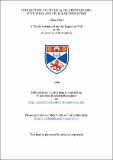Files in this item
Interaction of the HeLa cell protein EBP1 with viral and cellular enhancers
Item metadata
| dc.contributor.advisor | Hay, Ronald | |
| dc.contributor.author | Clark, Lilian | |
| dc.coverage.spatial | 280 p. | en_US |
| dc.date.accessioned | 2018-06-12T15:09:31Z | |
| dc.date.available | 2018-06-12T15:09:31Z | |
| dc.date.issued | 1989 | |
| dc.identifier.uri | https://hdl.handle.net/10023/13971 | |
| dc.description.abstract | A cellular protein, EBP1, was identified, which bound to the "core" region of the SV40 enhancer. The DNA sequences requirements for specific EBP1 binding distinguished this protein from a number of previously reported enhancer binding proteins, Multiple copies of the EBP1 binding site could serve, in vivo, to enhance transcription. The in vivo transcriptional activity of wild type and mutant SV40 enhancers correlated with EBP1 binding. Mutations that abolish EBP1 binding also severely reduced transcription, indicating that this protein may be important for SV40 enhancer activity. Nuclease protection and chemical probing studies identified purine bases and backbone phosphate groups which participate in the formation of a specific EBP1/DNA complex. "Footprinting" with hydroxyl radicals revealed deoxyribose residues in the binding site which are protected from cleavage by EBP1. Computer graphics were used to display this information indicating that EBP1 made specific base and backbone contacts over one complete turn of the DNA double helix, supporting a model whereby the protein makes sequence-specific contacts in the major groove, although binding may also be influenced by interactions in the minor groove. Competition and contact point analyses revealed that EBP1 bound similarly to sites present in several other viral and cellular enhancers. Mutational analysis of EBP1 binding sites identified base pairs important for specific EBP1/DNA complex formation. All high affinity binding sites contained the sequence 5'-GG(N)6CC-3'. Although single base pair changes in the region between the conserved guanines and cytosines can generally be tolerated, it is clear that the central six base pairs contribute to binding affinity. Mutations in the recognition site which could lead to gross structural changes in the DNA abolish EPB1 binding. | en_US |
| dc.language.iso | en | en_US |
| dc.publisher | University of St Andrews | |
| dc.subject.lcc | QH601.P7C6 | en |
| dc.subject.lcsh | Membranes (Biology) | en |
| dc.title | Interaction of the HeLa cell protein EBP1 with viral and cellular enhancers | en_US |
| dc.type | Thesis | en_US |
| dc.contributor.sponsor | Science and Engineering Research Council (SERC) | en_US |
| dc.type.qualificationlevel | Doctoral | en_US |
| dc.type.qualificationname | PhD Doctor of Philosophy | en_US |
| dc.publisher.institution | The University of St Andrews | en_US |
This item appears in the following Collection(s)
Items in the St Andrews Research Repository are protected by copyright, with all rights reserved, unless otherwise indicated.

